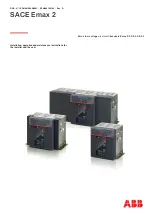
14
12
13
11
12
11
D I S TR I B UTI O N SO LUTI O N S
17
8.5. Main connections
The main connections are made by cables or
busbars (depending on the type of application and
the customer's requirements). The number of cables
and their section must be chosen to suit the
operating current required by the application and to
not exceed current density of 1 A/mm
2
.
Clean the contact surface using a non-abrasive cloth
of the Scotch Brite type so as to ensure optimum
contact resistance. Take care not to damage the
silver plating on the terminals. After this, connect
the cables or busbars (13) to each terminal (11, 12)
using M12 nuts and screws (14). Remember to insert
the locking washers as shown in the drawing.
Tighten the screws (14) to 84 Nm tightening torque.
Take care to position the cable terminals correctly
so as to maintain the required dielectric clearance
between the upper and lower terminals. Use screws
long enough to project 3-4 threads from their nuts,
but make sure that the screws are not too long,
otherwise the clearance will be unnecesarily
reduced.
IMPORTANT! In the case of busbar
connections and to avoid excessive
mechanical stress on the terminals due to
the weight on the actual busbars (11, 12),
the maximum distance between the
connection and the first support of the
busbar itself must not be more than 400
mm. Also take great care when aligning the
terminals-busbars, so as to avoid creating
mechanical stress on the circuit breaker
terminals.
Polarity of main circuit connection to circuit breaker
The DCBreak circuit breaker has a bidirectional
symmetric release. The forward biased normal
connection direction of the main circuit is as
follows:
+
connected to upper busbar (11)
–
connected to lower busbar (12)
Содержание DCBreak 1815
Страница 31: ...DISTRIBUTION SOLUTIONS 31 Notes ...




































